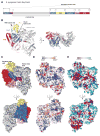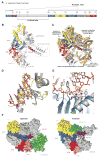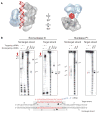Structures of Cas9 endonucleases reveal RNA-mediated conformational activation
- PMID: 24505130
- PMCID: PMC4184034
- DOI: 10.1126/science.1247997
Structures of Cas9 endonucleases reveal RNA-mediated conformational activation
Abstract
Type II CRISPR (clustered regularly interspaced short palindromic repeats)-Cas (CRISPR-associated) systems use an RNA-guided DNA endonuclease, Cas9, to generate double-strand breaks in invasive DNA during an adaptive bacterial immune response. Cas9 has been harnessed as a powerful tool for genome editing and gene regulation in many eukaryotic organisms. We report 2.6 and 2.2 angstrom resolution crystal structures of two major Cas9 enzyme subtypes, revealing the structural core shared by all Cas9 family members. The architectures of Cas9 enzymes define nucleic acid binding clefts, and single-particle electron microscopy reconstructions show that the two structural lobes harboring these clefts undergo guide RNA-induced reorientation to form a central channel where DNA substrates are bound. The observation that extensive structural rearrangements occur before target DNA duplex binding implicates guide RNA loading as a key step in Cas9 activation.
Figures








Comment in
-
Structural biology: activating and guiding Cas9.Nat Rev Microbiol. 2014 Apr;12(4):236-7. doi: 10.1038/nrmicro3237. Epub 2014 Feb 24. Nat Rev Microbiol. 2014. PMID: 24561484 No abstract available.
-
CRISPR snapshots of a gene-editing tool.Nat Methods. 2014 Apr;11(4):365. doi: 10.1038/nmeth.2912. Nat Methods. 2014. PMID: 24818224 No abstract available.
Similar articles
-
STRUCTURAL BIOLOGY. A Cas9-guide RNA complex preorganized for target DNA recognition.Science. 2015 Jun 26;348(6242):1477-81. doi: 10.1126/science.aab1452. Science. 2015. PMID: 26113724
-
Structures of a CRISPR-Cas9 R-loop complex primed for DNA cleavage.Science. 2016 Feb 19;351(6275):867-71. doi: 10.1126/science.aad8282. Epub 2016 Jan 14. Science. 2016. PMID: 26841432 Free PMC article.
-
Probing the structural dynamics of the CRISPR-Cas9 RNA-guided DNA-cleavage system by coarse-grained modeling.Proteins. 2017 Feb;85(2):342-353. doi: 10.1002/prot.25229. Epub 2017 Jan 5. Proteins. 2017. PMID: 27936513
-
Molecular architectures and mechanisms of Class 2 CRISPR-associated nucleases.Curr Opin Struct Biol. 2017 Dec;47:157-166. doi: 10.1016/j.sbi.2017.10.015. Epub 2017 Nov 3. Curr Opin Struct Biol. 2017. PMID: 29107822 Review.
-
Programmable DNA cleavage in vitro by Cas9.Biochem Soc Trans. 2013 Dec;41(6):1401-6. doi: 10.1042/BST20130164. Biochem Soc Trans. 2013. PMID: 24256227 Review.
Cited by
-
Probing Electrostatic Interactions in DNA-Bound CRISPR/Cas9 Complexes by Molecular Dynamics Simulations.ACS Omega. 2024 Oct 30;9(45):44974-44988. doi: 10.1021/acsomega.4c04359. eCollection 2024 Nov 12. ACS Omega. 2024. PMID: 39554421 Free PMC article.
-
Engineered PsCas9 enables therapeutic genome editing in mouse liver with lipid nanoparticles.Nat Commun. 2024 Nov 7;15(1):9173. doi: 10.1038/s41467-024-53418-8. Nat Commun. 2024. PMID: 39511150 Free PMC article.
-
Methylation Mesa define functional regulatory elements for targeted gene activation.Res Sq [Preprint]. 2024 Oct 16:rs.3.rs-4359582. doi: 10.21203/rs.3.rs-4359582/v1. Res Sq. 2024. PMID: 39483908 Free PMC article. Preprint.
-
Cleavage of DNA Substrate Containing Nucleotide Mismatch in the Complementary Region to sgRNA by Cas9 Endonuclease: Thermodynamic and Structural Features.Int J Mol Sci. 2024 Oct 9;25(19):10862. doi: 10.3390/ijms251910862. Int J Mol Sci. 2024. PMID: 39409191 Free PMC article.
-
Current Status of Biomedical Products for Gene and Cell Therapy of Recessive Dystrophic Epidermolysis Bullosa.Int J Mol Sci. 2024 Sep 24;25(19):10270. doi: 10.3390/ijms251910270. Int J Mol Sci. 2024. PMID: 39408598 Free PMC article. Review.
References
Publication types
MeSH terms
Substances
Associated data
- Actions
- Actions
- Actions
- Actions
Grants and funding
LinkOut - more resources
Full Text Sources
Other Literature Sources


